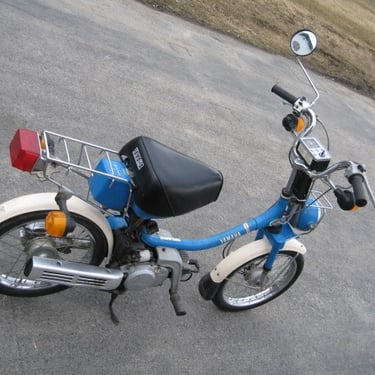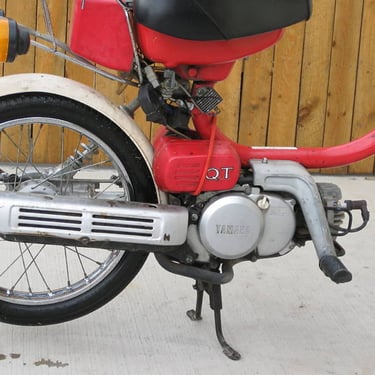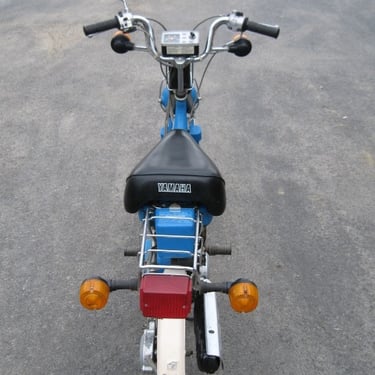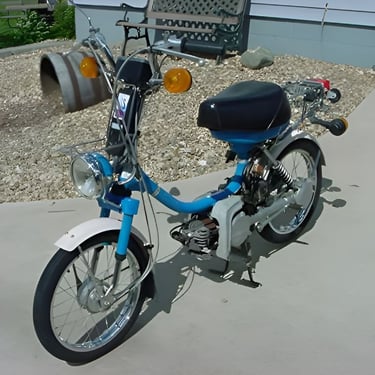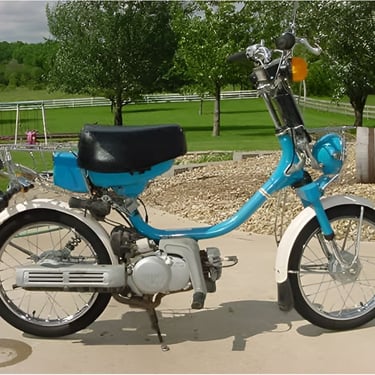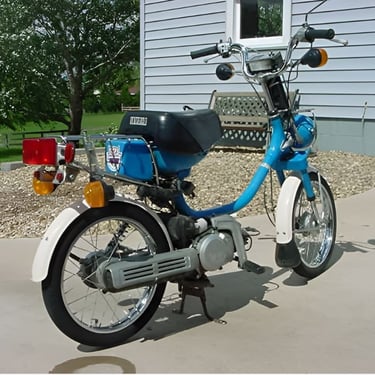The Yamaha QT50 Shaft Drive Moped: Yamahopper
The article provides a detailed overview of the Yamaha QT50, a popular moped model that was produced from 1979 to 1992. It covers the historical context, specifications and design, innovative features, and the enduring popularity and community surrounding the Yamahopper. The article highlights the QT50's accessibility, simplicity, and reliability, which made it a beloved choice for young riders seeking affordable and efficient transportation. It also discusses the moped's cult following and the various modifications and customizations that enthusiasts have incorporated over the years.
JAPAN TWO STROKEYAMAHA 1980'SNOPEDS
5/24/20243 min read
The Yamaha QT50 Shaft Drive Moped: Yamahopper
Introduction
The Yamaha QT50, affectionately known as the Yamahopper, carved an unforgettable niche in the history of mopeds. Produced from 1979 through 1992 by the Yamaha Motor Company, this iconic moped transcended mere transportation, becoming a symbol of freedom and innovation during its era. Its appeal lay not only in its compact design and fuel efficiency but also in its accessibility to teenagers, for whom owning a QT50 often meant their first foray into the world of vehicular independence.
Historical Context and Development
In an era marked by a global energy crisis, the late 1970s and early 1980s saw a pronounced shift towards fuel-efficient vehicles. Amidst soaring gas prices and growing environmental consciousness, the Yamaha QT50 emerged as a beacon of practicality and efficiency. Its development was a strategic response to these shifting dynamics, offering a cost-effective solution, particularly appealing to younger demographics seeking affordable transportation options. Historically, the QT50 was part of a broader movement that saw motorcycle manufacturers exploring the potential of small, efficient motorbikes as alternatives to larger, fuel-hungry vehicles. This period laid the groundwork for the QT50's introduction, where it would soon become a highly sought-after model for its blend of simplicity, economy, and reliability.
Specifications and Design
The Yamaha QT50, known for its distinctive noped design, boasted a modest but efficient 49cc two-stroke reed valve engine. This powerplant was uniquely situated beneath the frame, mirroring the configuration of more traditional motorcycles rather than standard mopeds. Its dimensions, featuring an overall length, width, and a low seat height, contributed to its easy handling and accessibility. Performance-wise, the QT50 was capable of reaching speeds up to 30 mph, making it suitable for city commutes.
One of the hallmark features of the QT50 was its maintenance-free shaft drive, contained within a single-sided swingarm. This design eliminated the need for regular chain maintenance, enhancing the moped's reliability and ease of care. Additionally, the QT50's charging and ignition system, consisting of a six-volt battery and alternator, simplified the starting process and contributed to its overall user-friendly nature. These specifications and design choices underlined Yamaha's commitment to creating a practical, low-maintenance vehicle that was both fun and economical to ride.
Features and Innovations
The Yamaha QT50 stood out not only for its compact form and practicality but also for a range of forward-thinking features that set it apart in the moped market. Among these was the Autolube oil injection system, which significantly reduced the mess and hassle associated with two-stroke oil and fuel mixing. The inclusion of solid-state CD ignition demonstrated Yamaha's commitment to employing advanced technology for reliability and ease of use.
Moreover, the unique charging and ignition system of the QT50 facilitated smoother starts, especially in cold conditions, highlighting Yamaha's attention to detail in creating a user-friendly experience. The maintenance-free shaft drive was a particular innovation, offering benefits such as reduced wear concerns and the elimination of regular chain maintenance tasks. These features not only simplified the ownership experience but also contributed to the QT50’s enduring popularity among enthusiasts seeking both functionality and minimal upkeep.
Popularity and Appeal
The Yamaha QT50's blend of affordability, efficiency, and ease of use propelled it to popularity, especially amongst teenage riders. In several states, its engine size—just under 50cc—allowed it to be operated without a driver's license, making it an attractive option for young individuals seeking a taste of freedom. This legal loophole turned the QT50 into more than just a mode of transportation; it became a rite of passage.
Besides its legal accessibility, the QT50 developed a cult following for its simplicity and reliability. The moped's straightforward mechanics made it an ideal candidate for first-time vehicle owners to learn basic maintenance and repair skills. As a result, a vibrant community emerged, centered around sharing knowledge, tips, and modifications for the QT50. This collective enthusiasm not only fostered a sense of belonging among owners but also ensured that even decades after its last production year, the Yamaha QT50 remains a cherished model within the moped and motorcycle communities.
Common Modifications and Community Contributions
The Yamaha QT50, while practical and efficient in its stock configuration, also served as an inspiring canvas for enthusiasts eager to personalize or enhance their mopeds. Popular modifications included swapping in cylinders, pistons, and rings from other Yamaha models like the YT60 and MJ50 Towny, aiming to boost performance or adapt to two-speed functionality. Additionally, upgrades to the carburetor and exhaust system were common, with many opting for Mikuni VM15 and VM18 carburetors or Jemco exhausts for improved airflow and power output.
The community surrounding the QT50 played a vital role in this culture of customization, sharing detailed guides, modification tips, and troubleshooting advice through forums and websites. This collaborative spirit not only made the QT50 more versatile but also deepened the connection owners felt with their mopeds and with one another. Whether for enhanced performance or simply a unique aesthetic, the possibilities offered by the QT50 ensured its status as a beloved project base for moped enthusiasts.


